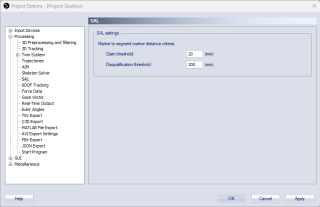SAL
Skeleton Assisted Labeling (SAL) uses the skeleton segment markers to identify unlabeled trajectories or parts that can be associated with them. It requires a solved skeleton to be able to identify trajectories. The unidentified trajectory part that is closest to a missing segment marker and fulfills the below criteria is added to the corresponding labeled trajectory.
SAL uses the following marker to segment marker distance criteria for labeling unidentified trajectory parts.
-
Claim threshold
Required closeness of a marker to a segment marker. At least one frame of an unidentified part must be within the claim threshold of a segment marker in order to be labeled as the corresponding trajectory. The default value is 20 mm. Use a lower value when markers can be close to each other for example when solving fingers. -
Disqualification threshold
The maximum tolerated distance of a marker to a segment marker. If any frame of a claimed part is beyond the disqualification threshold, it will be disqualified as a solution. This setting prevents that wrong unidentified markers that happened to be close to a missing segment marker at some instance are accepted as a solution. The default value is 200 mm.
For more information about SAL see chapter How to use SAL.
